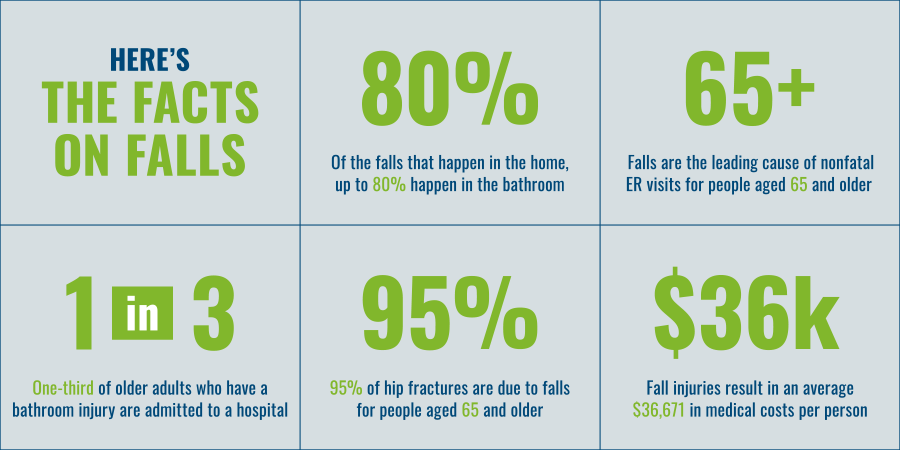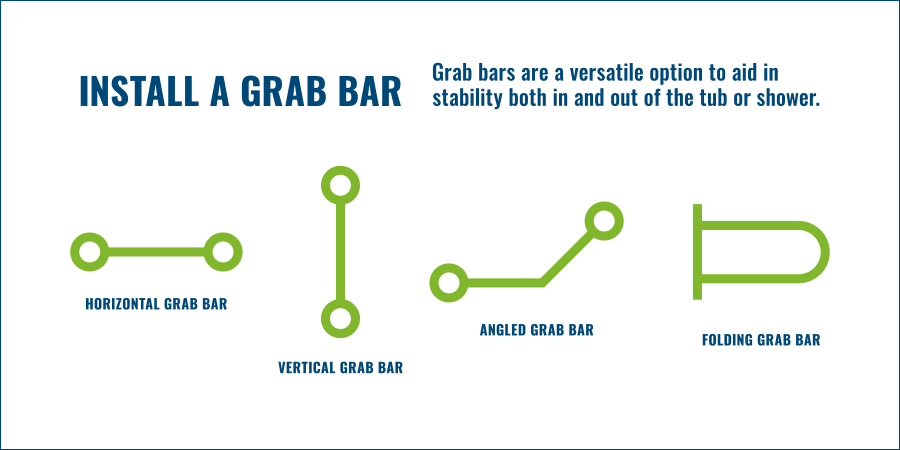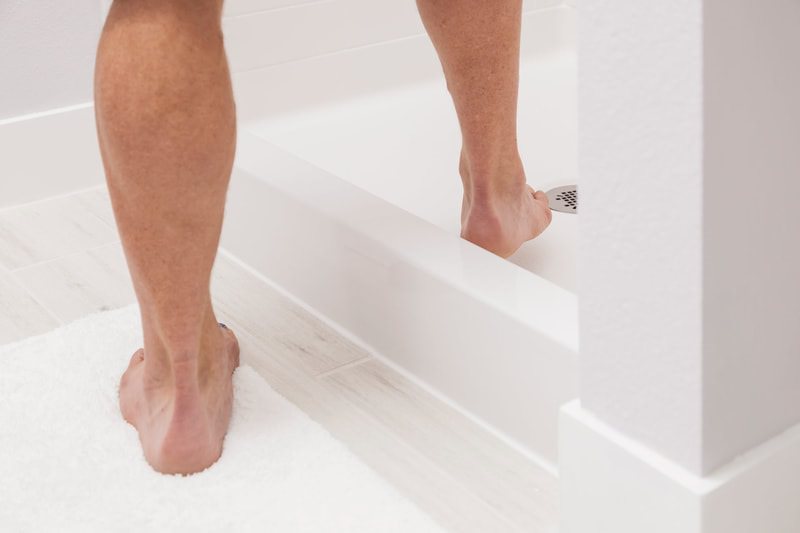

Did you know January is National Bath Safety Month? Join us in the effort to raise awareness about bathroom injuries and how to prevent them! While bathroom safety is important for everyone, it is especially important for people who use wheelchairs or have other mobility issues.


The truth is, bathroom injuries are commonplace. According to the Centers for Disease Control and Prevention, bathroom injuries result in 235,000 emergency room visits every year in the United States for people aged 15 and older.


Falls are the most common type of injury sustained in the bathroom, leading to 4 out of every 5 emergency room visits. While people of every age and ability face risks when using the shower, tub, sink, or toilet, bathroom injuries are most common amongst adults 65 years and older.
There are many reasons why older adults face higher risks. As people age, it is common to experience changes in balance, strength, mobility, health, and cognition. Each of these factors contributes toward a person’s risk for falls, slips, and other bathroom injuries. Similar to people of all ages, older adults also experience greater risks related to variables like medication use, choice of footwear, and safety of the living environment.
Facts about falls and bathroom injuries
Particularly for older adults, falls can lead to devastating and even deadly outcomes. Consider the following facts about falls:
- Falls are the leading cause of nonfatal emergency department visits for people aged 65 and older
- One-third of older adults who experience a bathroom injury are admitted to a hospital
- Falls are the most common cause of Traumatic Brain Injuries (TBI) and the second-leading cause of TBI-related deaths
- 95% of hip fractures are due to falls, with a 50% mortality rate within six months for people aged 65 and older
- Fall injuries result in an average $36,671 in medical costs per person
- 60% of falls occur in the home
- Of the falls that happen in the home, up to 80% happen in the bathroom


These statistics might sound alarming, but we also have good news to share: fall prevention is in your hands! There are several ways you can reduce your risk of falling at home as well as other bathroom injuries. By knowing the risks, taking care of your health, and establishing a safe living environment, you’ll improve bath safety and minimize accidents.
Read on and discover how to prevent the 5 most common bathroom injuries. For in-person help, contact your local accessibility experts at Next Day Access. We offer free consultations to help identify potential safety issues in your bathroom. We’ll also offer recommendations for the best product and design options to meet your needs!
1. Support yourself while bathing or showering.


Nearly a third of bathroom injuries occur while bathing or showering. This fact makes sense, doesn’t it? With a combination of slick surfaces, higher temperatures, and elevated tub rims or surrounds, people are more prone to slips, loss of balance, or fainting.
While bathtubs and showers are designed to protect your house from water damage, many lack the necessary safety precautions to prevent slipping. One of the quickest and easiest ways to improve traction is by purchasing anti-slip bath mats or stickers. To choose a bath mat or stickers that reduce risks in tub or shower, look for the following qualities:
- Non-slip or anti-slip material that support good underfoot traction when wet
- Strong grip to prevent movement against the tub or shower surface
- Ease of cleaning to protect against soap residue, mold, and mildew buildup
- Sufficient coverage to minimize contact with slippery surfaces
While mats and stickers offer some protection against slipping, they do not account for other injuries sustained while bathing including the loss of balance.


For greater protection, many individuals opt to bathe while seated or lying down. In addition to a non-slip mat, consider options like the Invisia Bath Bench, Rane Folding Shower Seat, or Rane Shower/Changing Bed. Additionally, grab bars and safety poles can improve stability for bathing while standing, seated, or lying down or transitioning between positions.
It is important to remember that even surfaces advertised as “slip resistant” can be hazardous as a result of soap residue, mildew, and mold buildup. For this reason, regularly clean all surfaces in your shower and tub–including mats–as an essential part of bath safety.
If you are interested in a bench, seat, or bed for your tub or shower, contact your local accessibility experts at Next Day Access. We offer free consultations to help you choose the best options particular to your needs and the design of your bathroom.


2. Reduce slip risks outside of the tub or shower.
Slipping is the second most common injury in the bathroom. Just like tubs and showers, bathroom floors are slippery when wet! And floors aren’t the only problem. Many bathroom rugs increase injury risks due to improper traction, drying capabilities, or curling. In fact, bathrooms are the most common place for rug- and carpet-related falls to occur in the home.
Fortunately, you can make a big difference with small additions to your bathroom like weighted shower curtains, non-slip rugs, and grab bars. Weighted shower curtains prevent excess water from leaking onto your floor outside of the tub or shower. If water happens to leak onto your floor while bathing, consider drying the floor before stepping out.
When properly designed, bath rugs can reduce instances of falling or slipping. To choose a bath rug that is more helpful than harmful, look for the following qualities:
- Non-slip, non-skid, or anti-slip backing can provide better traction for your feet
- Water absorbing can reduce the likelihood of slipping on wet surfaces
- Quick drying can limit degradation due to mold and mildew
- Low clearance can reduce the likelihood of tripping
Grab bars are a versatile option to aid in stability both in and out of the tub or shower. As the name suggests, grab bars are designed to be grasped while a person stands still, walks, or transitions between lying down, sitting, bending, or standing up.


Depending on your needs and the design of the bathroom, grab bars can be installed vertically, horizontally, or at an angle. You can choose from a wide range of grab bar styles and materials that fit your idea of home, including options with custom sizes. There are even designs that double as soap holders, shelves, and holders for towels and toilet paper.
Want help deciding where to install grab bars in your bathroom? Contact your local accessibility experts at Next Day Access for a free consultation and estimate. We’ll visit your home and identify how grab bars can aid your safe movement.
3. Take care while using the toilet.


The risks associated with getting on, off, or using the toilet increase dramatically with age, accounting for as many as 37% of bathroom injuries for adults 65 years and older. For people 85 years and older, this rate rises to 51%. In particular, toilets pose a risk for older adults who use the toilet more frequently due to urinary incontinence or those who experience changes in heart rate or blood pressure due to abdominal strain, dehydration, medication usage, or the transition between sitting and standing.
When it comes to toilet safety, slower is safer. Give yourself plenty of time to make your way to the bathroom, seat yourself on the toilet, and stand up afterward. Moving at a slower rate reduces the risk of slipping or tripping. Slow movements also offer some protection against heart rate and blood pressure changes when sitting or standing up that lead to fainting, light-headedness, or dizziness.
Additionally, there are a variety of products that support safer toilet use. A few of our favorites include the following:
Bidet seats. Bidet seats attach to your existing toilet and utilize a soft stream of water for cleaning as an alternative to toilet paper. They can reduce the risk of balance loss from twisting and bending to wipe with toilet paper. They also provide a slightly elevated seat for safer transition between sitting and standing. You can choose options that include heated seats, remote operation, and water pressure control for maximum comfort and ease of use.


Support arms and grab bars. Installing support arms or grab bars near the toilet provides greater stability when transitioning between sitting or standing, as well as while using the toilet. While grab bars can be used anywhere in the bathroom and beyond, support arms are specifically designed for use around toilets. The anti-slip arms provide steady support while using the toilet, as well as transitioning on or off of the seat.
Accessible washbasins. Accessible washbasins include features like support rails, flexible positions, and adjustable heights. With a wide variety of manual and electronic options available, accessible washbasins provide greater ease of use and movement in the bathroom.
Want professional input? Contact your local accessibility experts at Next Day Access for a free consultation. We can help you design a safer, smarter bathroom.
4. Prepare to exit the tub or shower safely.


The fourth most common cause of bathroom accidents involves exiting the tub or shower. These accidents often involve tripping over the surround, rim, or lip, or the loss of balance while stepping over them. With approval from a healthcare provider, older adults can exercise to improve function and balance that reduces the risk of falls by as much as 24%.
Because injuries while exiting the tub happen to people of all ages, the U.S. Centers for Disease and Prevention suggests that “adding grab bars both inside and outside the tub or shower might help prevent bathroom injuries to all household residents.” In fact, a recent study showed a recovery of balance 75.8% more often for participants who used a grab bar than those without. In addition to grab bars, other supportive products like safety poles and support arms can further reduce the risk of accidents while exiting the tub or shower.
Curious to know what a safe exit system looks like? Elder Care Consultant Cynthia Wilson offers a brief demonstration of the grab bars installed in her mother’s bathroom. Notice how each grab bar is strategically placed. Cynthia’s mother can use the grab bars to support herself while standing up from the shower bench and taking her first and last steps out of the tub.


Baignoires à l'italienne are another great option for safe entrance and exit from the tub or shower. Walk-in tubs utilize a door that swings open and shut for easy access, and seals watertight for bathing or showering. We offer a wide range of conversion kits, freestanding, and built-in models that fit bathrooms of nearly any size.
You can schedule a free consultation by contacting your local accessibility experts at Next Day Access. We can help you design a safe exit system in your bathroom and install it within hours!
5. Protect yourself from fainting bathroom injuries.
The fifth most common injury sustained in bathrooms relates to fainting. Many fainting injuries relate to a sudden change in heart rate or blood pressure that is referred to in medical terms as “syncope.” Syncope is a common type of fainting that happens suddenly, lasts for a very short time, and ends with spontaneous recovery. While syncope does not always indicate an emergency on its own, the sudden loss of consciousness in small spaces like bathrooms can lead to serious injuries that require medical attention.
The origins of syncope vary greatly including cardiac, neurological, endocrinological, and psychiatric causes. The most common form of syncope is reflex or “vasovagal,” representing a third of cases. Vasovagal syncope involves a nervous system malfunction that can occur in response to the following:
- Sitting or standing position
- Severe emotional distress
- Sudden pain or injury
- Overheating
- Dehydration
- Diuretic or vasodilator use
For individuals with higher risk factors for syncope or other forms of fainting, consider the installation of grab bars and safety poles. These supportive products can increase your peace of mind and help during the early onset of a fainting spell while you still have consciousness.
You can further protect yourself from fainting injuries by recognizing the warning signs. Some, though not all, episodes are preceded by symptoms including:
- Nausea or vomiting
- Abdominal pain
- Feeling dizzy or light-headed
- Sweating
- Palpitations
If you experience these symptoms in the bathroom, you can reduce the risk of injury by getting flat on the floor. Lie down as safely and quickly as you can, with legs elevated if it is possible. If you cannot flat, consider sitting with your head between your knees. Once your symptoms pass or you regain consciousness, be sure to check in with your medical provider. Sometimes, fainting spells can indicate more serious issues that require immediate attention.
Don’t delay, reach out today.


We hope this article has provided helpful information about bath safety! Please note that this article is intended for informational purposes only and is not a substitute for medical advice. We advise you to consult with your healthcare provider about recommended fall prevention strategies related to medication, exercise, or other lifestyle changes.
If you want help deciding on the best bathroom products for your home, we’re here to help. Contact your local accessibility experts at Next Day Access for a free consultation and estimate. We’ll listen to your thoughts, identify risks, and provide recommendations that increase your peace of mind and support your safety in the bathroom.





